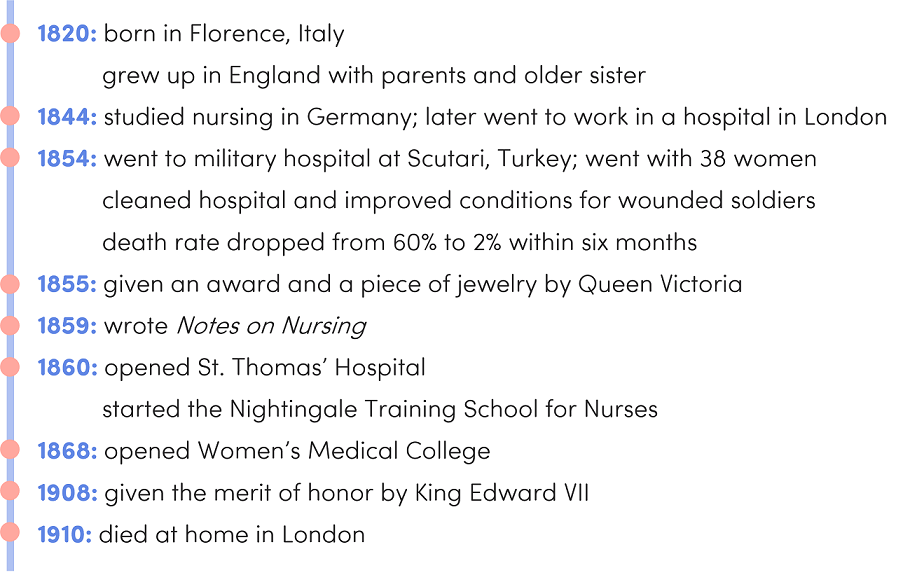Write a biography (120 – 150 words) about Florence Nightingale, using the information given below.

Hãy nhập câu hỏi của bạn vào đây, nếu là tài khoản VIP, bạn sẽ được ưu tiên trả lời.


x>y
hết
s
o
s
ss
s
s
s
s
sssssssssssssssss
s
s
e
x
x
x
xx
x
x
x

Đề câu a là \(\dfrac{-1}{4+x}-2\) phải không bạn. Trong trường hợp này x=-4 biểu thức không xác định nên không thể với mọi x được.

Ta có thể dùng cosy hoặc đặt a,b lần lượt là hai số hạng vế trái của phương, đưa phương trình về hệ phương trình không triệt để. Từ đó giải phương.
Đầu kiện: \(x\ge0\)
Ta có:
\(4\sqrt{x}=2\sqrt{4x}\le4+x\\ \Rightarrow x^2+4-4\sqrt{x}\ge x^2-x\\ \Rightarrow\sqrt{x^2+4-4\sqrt{x}}\ge\sqrt{x^2-x}\)
\(6\sqrt{x}=2\sqrt{9x}\le9+x\\ \Rightarrow\sqrt{x^2+4-6\sqrt{x}}\ge\sqrt{x^2-x-5}\)
Suy ra \(1\ge\sqrt{x^2-x}+\sqrt{x^2-x-5}\)
Đặt \(\sqrt{x^2-x}=a;0\le a\le1\\ \sqrt{x^2-x-5}=b;0\le b\le1.\\ \Rightarrow a^2-b^2=\left(x^2-x\right)-\left(x^2-x-5\right)=5.Vôlí\)
Vậy phương trình đã cho vô nghiệm.

a.
Số 2 ở hàng đơn vị trong dãy số trên là dãy số: \(22;32;42;...;292;302\)
Số chữ số 2 ở hàng đơn vị trong dãy số trên bằng: \(\dfrac{302-22}{10}+1=29.số\)
Số 2 được viết ở hàng trục trong dãy số trên là dãy số:\(20;22;24;26;28;\\ 120;122;124;126;128;\\ 220;222;224;226;228\)
Số chữ số 2 được viết ở hàng trục là: \(5\times3=15.số\)
Số 2 được viết ở hàng trăm là dãy số: \(200;202;204;....;296;298\)
Số chữ số 2 được dùng ở hàng trăm trong dãy số trên là: \(\dfrac{298-200}{2}+1=50.số\)
Số chữ số 2 được dùng trong dãy số đã cho là: \(29+15+50=94.số\)
b.
Dãy số \(14;16;18;...;98\) cần dùng số chữ số để viết là: \(\left(\dfrac{98-14}{2}+1\right)\times2=86\)
Để viết được 366 chữ số ta cần dùng thêm các số có 3 chữ số để viết thêm: \(366-86=280.số\)
Ta có \(280:3=93.dư.1\)
Vậy chữ số 366 là chữ số hàng trăm của số thứ 94 trong dãy: \(100;102;....;304\)
Số thứ 94 trong dãy trên bằng: \(\left(94-1\right)\times2+100=286\)
Chữ số 366 trong dãy số đã cho là chữ số 2.

Đầu kiện: \(x+y\ne0\Leftrightarrow x\ne-y\)
Ta có:
\(3x^3-y^3=\dfrac{1}{x+y}\\ \Leftrightarrow\left(3x^3-y^3\right)\left(x+y\right)=1\\ \Leftrightarrow\left(3x^3-y^3\right)\left(x+y\right)=\left(x^2+y^2\right)^2\)(*)
Xét \(y=0\Rightarrow x=\pm1\) thay vào phương trình (*) ta thấy không thõa mãn.
Với \(y\ne0\) chia hai vế phương trình (*) cho \(y^4\) ta có:
\(\dfrac{\left(3x^3-y^3\right)\left(x+y\right)}{y^4}=\dfrac{\left(x^2+y^2\right)^2}{y^4}\\ \Leftrightarrow\left(\dfrac{3x^3}{y^3}-1\right)\left(\dfrac{x}{y}+1\right)=\left(\dfrac{x^2}{y^2}+1\right)^2\)
Đặt \(t=\dfrac{x}{y}\) thay vào phương trình trên ta có:
\(\left(3t^3-1\right)\left(t+1\right)=\left(t^2+1\right)^2\)
\(\Leftrightarrow3t^4-t+3t^3-1=t^4+2t^2+1\\ \Leftrightarrow2t^4+3t^3-2t^2-t-2=0\\ \)
\(\Leftrightarrow2t^3\left(t+2\right)-t^2\left(t+2\right)-\left(t+2\right)=0\\ \Leftrightarrow\left(t+2\right)\left(2t^3-t^2-1\right)=0\\ \Leftrightarrow\left(t+2\right)\left(t^3-1+t^3-t^2=0\right)\\ \Leftrightarrow\left(t+2\right)\left(t-1\right)\left(2t^2+t+1\right)=0\\ \)
\(\Rightarrow\left[{}\begin{matrix}t+2=0\\t-1=0\\2t^2+t+1=0\end{matrix}\right.\Rightarrow\left[{}\begin{matrix}t=-2\\t=1\\\Delta< 0,vô.nghiệm\end{matrix}\right.\)
\(\Rightarrow\left[{}\begin{matrix}x=-2y\\x=y\end{matrix}\right.\)
Thay x vào phương trình \(x^2+y^2=1\) tìm y => x.
So với đầu kiện bài toán kết luận nghiệm

Gọi CTPT của Y là \(C_xH_yO_z\)
Ta có: \(n_{O_2}=\dfrac{4}{32}=0,125\left(mol\right)\)
Gọi \(\left\{{}\begin{matrix}n_{CO_2}=x\left(mol\right)\\n_{H_2O}=y\left(mol\right)\end{matrix}\right.\Rightarrow x:y=2:1\left(1\right)\)
Theo ĐLBTKL: \(m_Y+m_{O_2}=m_{CO_2}+m_{H_2O}\)
`=>` \(m_{CO_2}+m_{H_2O}=4+3,95=7,95\left(g\right)\)
`=> 44x + 18y = 7,95 (2)`
Từ `(1), (2) =>` \(\left\{{}\begin{matrix}x=0,15\left(mol\right)\\y=0,075\left(mol\right)\end{matrix}\right.\) `=>` \(\left\{{}\begin{matrix}n_C=0,15\left(mol\right)\\n_H=0,15\left(mol\right)\end{matrix}\right.\)
\(\xrightarrow[]{\text{BTNT O}}n_{O\left(Y\right)}+2n_{O_2}=2n_{CO_2}+n_{H_2O}\)
`=>` \(n_{O\left(Y\right)}=2.0,15+0,075-0,125.2=0,125\left(mol\right)\)
`=>` \(x:y:z=0,15:0,15:0,125=6:6:5\)
Do Y có CTPT trùng với CTĐGN `=>` CTPT của Y là `C_6H_6O_5`
Mà Y phản ứng với NaOH với tỉ lệ mol 1 : 2
`=>` Y là este 2 chức và có gốc ancol tạo thành tử etylen glicol
`=>` CTCT của Y là \(HOOC-C\equiv C-COOC_2H_4OH\)
`=>` X là \(HOOC-C\equiv C-COOH\)
`- A` đúng vì `6 + 2 = 8`
`- B` sai do X có chứa liên kết \(C\equiv C\) nên không có đồng phân hình học
`- C` đúng vì trong CTCT của Y không có gốc \(-CHO\)
`- D` đúng vì có liên kết \(C\equiv C\) trong CTCT
Bai nay lam gi co trong lop 1 :))??
Cai nay cho len lop 11 moi dung :))

From : ...
To : ...
Subject : The camera
Hi,
I'm ........ Are you the company called : ....... that product camera? I have a litte issue about your camera : Last week, I went to the store and bought a new camera which is made by your company. I like it very much. But this morning, when I'm going to take a picture of a flower, I realize that it isn't working any more. I checked it again and it's still not working. I didn't do anything like drop it to the ground since I bought it. I think there's some problem inside it. I'm really worry about the camera. What do you think the problem is? Can you come to my house and check the camera? I'm free tomorrow. If you can, please come by. Here's my address : ...........
Thank you!
t
Florence Nightingale is most famous for being the founder of modern nursing.
She was born in 1820 in Florence, Italy. She grew up in England with her parents and older sister. In 1844, she studied nursing in Germany and later went to London to work in a hospital. In 1854, Florence went to the military hospital in Scutari, Turkey, with 38 other women. They cleaned the hospital and improved conditions for the wounded soldiers. The death rate dropped from sixty percent to two percent within six months. In 1855, Queen Victoria gave Florence an award and a piece of jewelry. Florence wrote Notes on Nursing in 1859 and in 1860, she opened St. Thomas' Hospital where she started the Nightingale Training School for Nurses. In 1908, she was given the merit of honor by King Edward VII. She died two years later in London. Florence Nightingale will be remembered for being the founder of modern nursing.